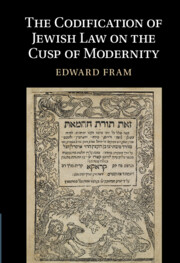Book contents
- The Codification of Jewish Law on the Cusp of Modernity
- The Codification of Jewish Law on the Cusp of Modernity
- Copyright page
- Dedication
- Contents
- Acknowledgments
- Abbreviations and Rules of Style
- Maps
- Introduction
- 1 Joseph Caro and His Codification of Jewish Law
- 2 A Difficult Beginning
- 3 Rabbi Solomon Luria’s Legal Methodology
- 4 Rabbi Moses Isserles’s Responses
- 5 Codification and Legal Creativity
- Conclusions
- Bibliography
- Index
2 - A Difficult Beginning
Published online by Cambridge University Press: 21 April 2022
- The Codification of Jewish Law on the Cusp of Modernity
- The Codification of Jewish Law on the Cusp of Modernity
- Copyright page
- Dedication
- Contents
- Acknowledgments
- Abbreviations and Rules of Style
- Maps
- Introduction
- 1 Joseph Caro and His Codification of Jewish Law
- 2 A Difficult Beginning
- 3 Rabbi Solomon Luria’s Legal Methodology
- 4 Rabbi Moses Isserles’s Responses
- 5 Codification and Legal Creativity
- Conclusions
- Bibliography
- Index
Summary
In the 1550s and 1560s, Caro’s Beyt Yosef and Shulḥan `aruk were the most up-to-date, comprehensive legal codes of Jewish law. Yet, at about the same time, another expansive work on Jewish law was being written by Solomon Luria. Luria had completed a section of his book by late summer 1551.1 He showed the material to Rabbi Kalman of Worms (d. 1560), the rabbi of Lwów, and asked him to write a letter of support for the volume, which Rabbi Kalman did in mid-September of that year.2 Rabbi Kalman noted that he had seen “the stand-alone book [sefer ha-ḥibbur] that the distinguished [mubhaq] rabbi [i.e., Luria] had composed” and went on to praise Luria’s abilities of deduction, originality, and writing skills.3 Rabbi Kalman made no mention of the title of the book.4
Information
- Type
- Chapter
- Information
- The Codification of Jewish Law on the Cusp of Modernity , pp. 88 - 130Publisher: Cambridge University PressPrint publication year: 2022
